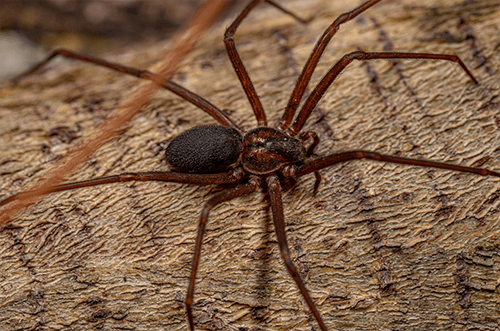Summer Spiders: Brown Recluse

Whether you’re tackling yard projects, decluttering your shed or garage, or pulling things out of the attic, it’s important to be aware of the risk of encountering a brown recluse spider.
These spiders, also known as violin spiders, are one of the most venomous spiders in North America. They are typically found in the Midwest and Southern regions of the United States. While bites from brown recluse spiders are relatively rare, they can be quite dangerous and should be taken seriously.
What Do Brown Recluse Spiders Look Like?
These spiders are about the size of a quarter and are usually light to dark brown in color. They have a characteristic violin-shaped marking on their back, with the neck of the “violin” pointing toward the spider’s head. Brown recluse spiders have six eyes whereas most spiders have eight eyes. However, it can be difficult to identify spiders based on their appearance alone, as many other spiders have similar markings.
Where Are Brown Recluse Spiders Found?
As the “recluse” in their name implies, these spiders prefer to live in habitats that feature secluded, dry, sheltered areas, including underneath structures, logs, or piles of rocks or leaves. If a brown recluse spider finds its way indoors, they will try to find locations with similar features, such as closets, attics, inside shoes, or bedding.
How Can I Prevent a Brown Recluse Spider Bite?
Like most spiders, this type only bites humans if there is pressure applied to them. For example, if you put on a shoe that has a spider in it, the pressure between your foot and the shoe will cause the spider to bite. The best way to avoid bites is to prevent contact with the spiders themselves.
Ways to prevent bites include:
- Inspect and shake out items that have been in storage for a duration of time. This may include shoes, clothing, tools, planters, and even children’s toys.
- Check your bedding and sheets before getting into bed.
- Consider storing clothing, shoes, and bedding in sealed plastic containers.
- Do not stack wood directly against your house.
- When handling wood piles, or other piles of materials that may be in your yard, inspect for spider webs and similar types of spiders. Wear gloves and other protective clothing like closed toed shoes and long sleeved pants and shirts.
What Are Signs and Symptoms of a Brown Recluse Spider Bite?
- Pain and/or itching occurs around the bite site.
- “Bull’s eye” or target-like lesions at bite sites with a white blister in the center surrounded by rings of red. When left untreated, the white blister turns black as the skin tissue dies.
- Severe reactions to bites can cause fever, chills, nausea, vomiting, bleeding problems and dark urine within 24 hours.
How Should I Treat a Brown Recluse Spider Bite?
If you think you may have been bitten by a brown recluse spider, contact the Poison Help line to be connected to a Poison Control Center. Unless an anaphylactic reaction occurs you would call 911. Poisonous spider bites typically require medical attention to monitor for severe reactions and make sure the wound heals safely. Some first aid tips include:
- Clean the bite site with soap and water.
- Keep the bite site elevated if possible to avoid swelling.
- Applying a cool compress to the area can help to reduce swelling and discomfort.
Brown recluse spiders are a dangerous species of spider that should be treated with caution. By taking steps to prevent contact with the spiders and seeking medical attention if bitten, you can minimize your risk of experiencing serious symptoms. If you are unsure what type of spider you have encountered or are concerned about a bite, call our poison control experts toll-free at 1-800-222-1222 or visit PoisonHelp.org.